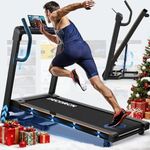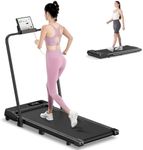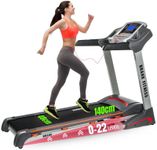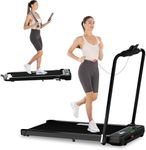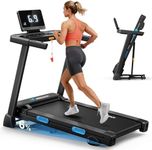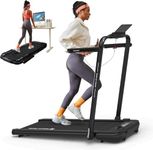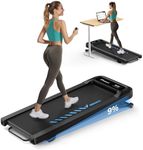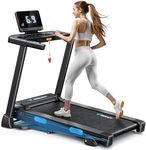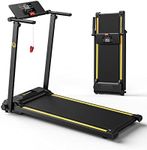Buying Guide for the Best Foldable Treadmills
Choosing the right foldable treadmill can be a great way to ensure you stay fit while saving space in your home. Foldable treadmills are designed to be compact and easy to store, making them ideal for small living spaces. When selecting a foldable treadmill, it's important to consider several key specifications to ensure you get the best fit for your needs. Here are some important specs to look at and how to navigate them.Motor PowerMotor power is measured in horsepower (HP) and determines how smoothly and efficiently the treadmill runs. A higher HP means the treadmill can handle more intense workouts and heavier usage. For light walking or jogging, a motor with 1.5 to 2.0 HP is sufficient. For running or more frequent use, look for a motor with 2.5 to 3.0 HP or higher. Consider your workout intensity and frequency to choose the right motor power.
Running SurfaceThe running surface, or belt size, is crucial for comfort and safety during your workout. A wider and longer belt provides more room to move and reduces the risk of tripping. For walking, a belt size of around 16-18 inches wide and 45 inches long is adequate. For running, aim for at least 20 inches wide and 55 inches long. Think about your stride length and workout type to determine the best running surface size for you.
Foldability and StorageFoldability refers to how easily the treadmill can be folded and stored away. Some treadmills have a hydraulic system that makes folding effortless, while others may require manual effort. Consider the ease of folding and the space available for storage in your home. If you have limited space, look for a treadmill that folds compactly and has wheels for easy movement.
Weight CapacityWeight capacity indicates the maximum user weight the treadmill can support. It's important to choose a treadmill that can handle your weight to ensure durability and safety. Most foldable treadmills have a weight capacity ranging from 220 to 300 pounds. Select a treadmill with a weight capacity that exceeds your weight to ensure stability and longevity.
Speed RangeThe speed range of a treadmill determines how fast you can go during your workout. For walking, a speed range of 0.5 to 4 mph is sufficient. For jogging or running, look for a treadmill with a speed range of up to 10 mph or higher. Consider your fitness goals and preferred workout intensity to choose the right speed range.
Incline OptionsIncline options allow you to simulate uphill running or walking, adding variety and intensity to your workouts. Some treadmills offer manual incline adjustment, while others have motorized incline settings. For basic workouts, a manual incline of up to 10% is adequate. For more advanced training, look for motorized incline options up to 15% or higher. Think about how you want to challenge yourself and vary your workouts when choosing incline options.
Console FeaturesConsole features include the display and controls on the treadmill. Look for a console that is easy to read and use, with features like speed, distance, time, and calorie tracking. Additional features like heart rate monitors, preset workout programs, and connectivity options (Bluetooth, USB) can enhance your workout experience. Consider which features are important to you and will help you stay motivated and track your progress.



